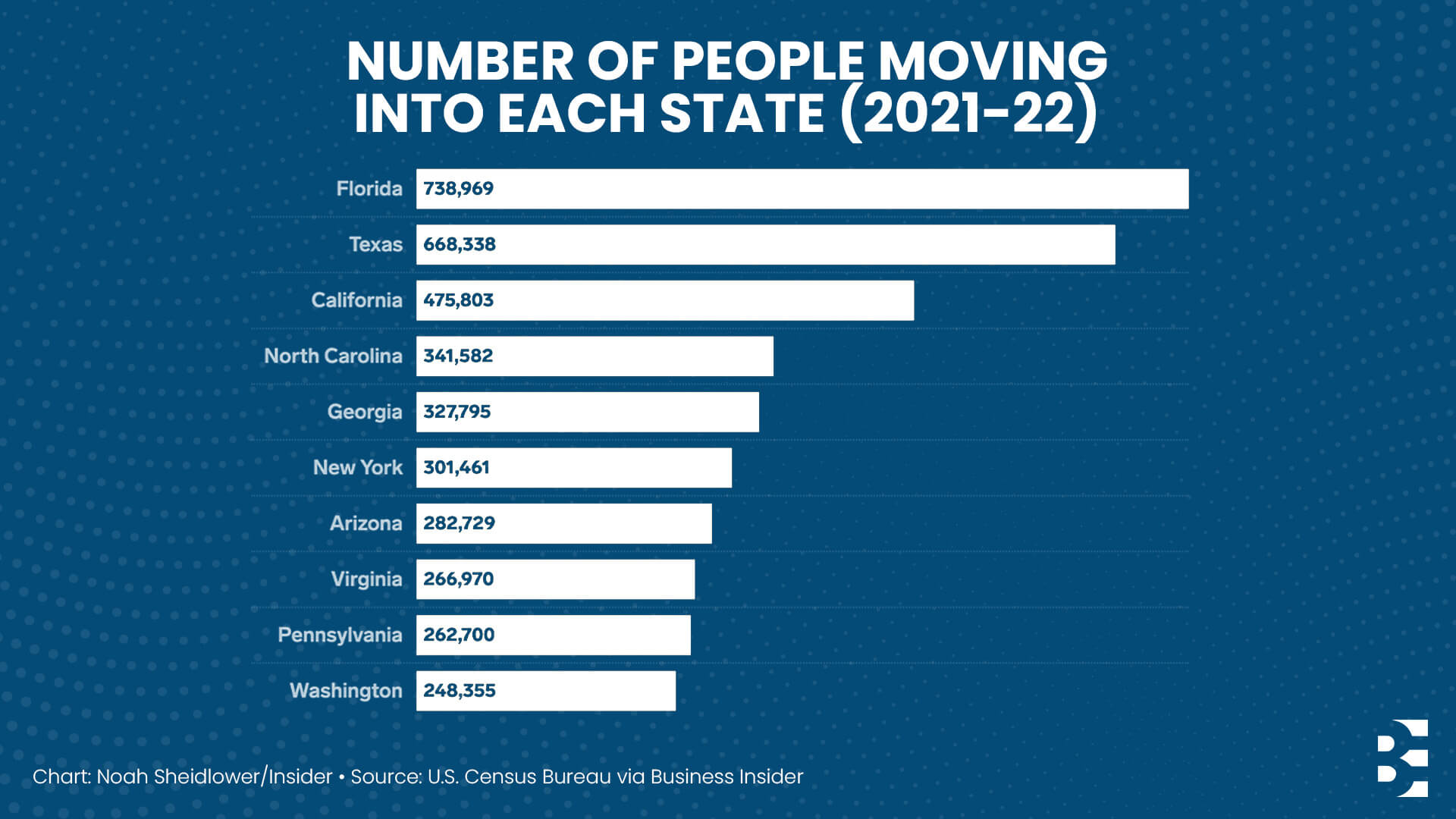Presented by:
Texas has become a top destination for real estate investors thanks to its thriving economy and attractive multifamily fundamentals. Major metros like Austin and Dallas-Fort Worth are magnets for corporate relocations and domestic migration, key factors behind the state’s surging job growth and housing demand.
Here, we’ll dive deeper into population growth, job growth, and other core fundamentals that position Texas as (still) one of the most desirable states for multifamily investors in 2024.
Surging Population Means Increased Demand
Since 2000, more than 9 million people have relocated to Texas, and between 2021 and 2022 alone, more than 650,000 people moved to the Lone Star State, according to Census Bureau data. Only Florida welcomed more residents during that time. Texas passed the 30 million mark in total population in 2022 and is second only to California — which, while sitting at nearly 40 million residents, has seen a mass post-pandemic exodus that has seen its total population decrease significantly, with more than 800,000 leaving the state during that same 2021-22 window.

There are several reasons as to why so many Americans are moving to Texas, affordability being chief among them. Texas ranks 30th in the nation in housing affordability, 33rd in cost of living, and has no state income tax. The cost of living in Texas is around 8% lower than the national average, making it an attractive option for those considering relocation. The median home sale price is also lower, at $337,100 as of November — nearly $72,000 less than the national median sale price of $408,732.
While overall affordability is certainly a draw, among the primary forces driving migration to Texas are the job opportunities the state offers its residents to earn a reasonable income in some of the nation’s top booming industries.
Record Job Growth Creates Opportunities for New Residents
For the second year in a row in 2023, Texas boasted the most Fortune 500 companies with 55 headquartered in the state. The largest are Exxon Mobil and McKesson, both located in Irving, while Round Rock's Dell Technologies led Austin-area companies at No. 34 on the list, followed by Tesla at No. 50 and Oracle at No. 101. Because companies like CBRE, Caterpillar, and Hewlett-Packard — as well as the aforementioned Tesla and Oracle — moved their headquarters to Texas in recent years, Texas reported 33 months of uninterrupted job growth as of November 2023.
Between September 2022 and October 2023, Texas’s employment grew by 435,800 positions as its annual growth rate of 3.2 percent outpaced the nation by 1.1 percentage points. During that time, Texas recorded historic milestones in job count, boasting 14 million total jobs.
When it comes to long-term, sustainable growth, affordability doesn’t mean much if there are not enough good jobs to draw new residents. Conversely, if there is a bevy of good jobs available yet the cost of living is generally prohibitive (or at least not desirable compared to other states), job growth is rendered moot.
The fact that Texas is among the nation’s leaders in both has led to a historic migration that has one of the nation’s fastest-growing states gaining even more momentum heading into 2024.
What It All Means: Opportunity
It’s no secret that 2023 has been an interesting year for real estate in general, and especially for ground-up multifamily construction. Securing financing for multifamily construction has been challenging as banks have reduced real estate lending. This tightening of capital has drastically slowed new project starts.
According to GlobeSt.com, new multifamily construction starts have dropped across Texas from 2022 at a sizable margin. Houston multifamily starts have fallen by 79%, Austin by 74%, and Dallas-Fort Worth by 64%. With fewer units coming online and the migration to Texas showing no signs of slowing, this will create a future supply and demand imbalance that, to investors, can mean only one thing.
Opportunity.
Once the multifamily projects currently under construction are completed and leased up, there won’t be very many new properties coming online behind them. At BV Captial, a Texas-based real estate private equity firm, we expect to see this supply-demand imbalance materialize in 2025, so the construction projects that begin today will provide some of the few new multifamily properties that will come online in 2025. We are particularly bullish on Class A multifamily builds in Texas, given the high demand and constrained supply — an imbalance that has historically driven rents higher, increasing net operating income (NOI) and thus increasing returns for investors.
As a real estate investor, as you devise your investment strategy for 2024 and select the top markets in which you plan to invest, consider the strong fundamentals that Texas real estate still possesses. With strong population growth anchored by overall affordability and record job growth led by the relocation and expansion of some of the nation’s largest companies, the only thing brighter than Texas’s past is its future.
About BV Capital:
BV Capital is a Texas-based real estate private equity company that is part of the Bridgeview Real Estate family of companies. BV specializes in ground-up multifamily construction deals in the state of Texas and has its own in-house construction company, which has allowed it to achieve historical returns beyond those of traditional value-add investments. They have also never lost investor money and have never made a capital call. If you are an accredited investor interested in multifamily development opportunities in one of the fastest-growing states, visit bvcapitaltx.com/bestever.
Disclaimer:
The views and opinions expressed in this blog post are provided for informational purposes only and should not be construed as an offer to buy or sell any securities or to make or consider any investment or course of action.

